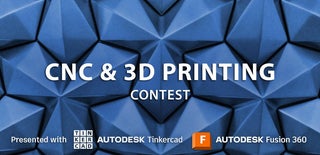Introduction: Resolve-Ables: Visualize Magnetic Fields With a Light Painting Wearable
*The Resolve-Ables project is a collection of wearable devices that enable visualization of phenomena we can’t see with our biological senses.
Ever since I got my first magnet implant, I've been obsessed with magnetic fields. I wanted a way to share the fields that I sense with other people. My idea is to visualize magnetic fields through a light painting wearable. When a magnetic field is detected with a GMR sensor, a NeoPixel stick will light up to represent the field strength, and when photographed using long exposure you can visualize different strengths of the field. The way the NeoPixels lights up can be reprogrammed to create several interesting effects (blinking, colors, number of pixels lit up, etc...) to create visually interesting combinations.
In this Instructable you'll learn how to order, fabricate, program, and assemble your own light painting wearable to visualize magnetic fields. The functionality of the device is also pretty open-ended so that you can add different sensors or different types of Neopixels for more light painting possibilities!
This project is partially sponsored by PCBWay, who fabricated and shipped the PCB. They also 3D printed all the parts in this Instructable. I highly recommend the service, the quality/value is great!
If you have any questions, want to keep up with my work, or toss around ideas, please do so on my Twitter: @4Eyes6Senses. Thanks!
Supplies
1x Arduino Nano (I Used the 33 BLE Version)
1x Adafruit MiniBoost 5V @ 1A - TPS61023
1x Slide Switch
1x AAH002-02E PCBA: Ultrahigh Sensitivity Analog Sensor (Or Order a AAH002-02E, AG005-06 PCB, and a Differential Amplifier)
1x Custom PCB (Gerber files can be found here - use PCBWay to order the PCB)
1x NeoPixel Stick - 8 x 5050 RGBW LEDs - Cool
1x 1 Foot Paracord
1x Wearable Bottom (File Below)
1x Wearable Middle (File Below)
1x Wearable Top (File Below)
1x Wearable Switch Extender (File Below)
1x Finger Wearable (File Below) - This file is a remix of the design by Ibataeva's "Custom 3D Printed Finger Splint" on Instructables
Step 1: Secure Armband to the Bottom Part
Secure the velcro armband in the slot of the bottom part. I recommend moving the plastic buckle near the side of the part (Figure 2) to help with future steps.
Step 2: Place Battery in the Middle Part Compartment
Locate the battery compartment on the bottom side of the middle part (Figure 1). Place the lipo battery in the compartment and thread the lipo's JST and wire through the hole (Figure 2 & 3).
Step 3: Screw the Middle and Bottom Part Together
Screw the M3 screws through both the middle and bottom parts until the screws are just visible (Figure 1). The buckle should also be sitting near the side of the device (Figure 2), adjust it until it is sitting correctly.
Step 4: Populate PCB and Thread Lipo JST/Wire Through the PCB
Populate the PCB (Figure 1) with the slide switch, a Arduino Nano, a MiniBoost, a two-pin female JSTs (from kit), and ten three-pin female JSTs (from kit). Clip any exposed headers on the bottom of the PCB so that it can sit flat (Figure 2). Thread the lipo's JST and cable through the PCB (Figure 3) and plug it into the female two-pin JST on the PCB (Figure 4). The PCB will sit loosely in the middle part until the top is screwed on, but you can add a little hot glue for extra security.
Step 5: Attach Slide Switch Extender
Attach the slide switch extender to the switch, it may take a little pressure but be careful not to break the switch itself. My part fit on the switch without any need for glue (Figure 2).
Step 6: Program the Arduino Nano
Included in this Instructable are three files I used to create my light paintings. One will actuate the Neopixel stick linearly with magnetic field intensity (red -> white), the second is also linear but all Neopixels will be white, and the third will blink the Neopixel stick to create a "disconnected" effect (my personal favorite).
Step 7: Prepare Neopixel Stick and GMR Sensor
Solder the jumper wire (about 1.5 feet per wire) to the Neopixel stick and GMR sensor, I added some hot glue and braided the wire for extra strength, I recommend marking each wire with a sharpie before branding so that you can identify what wire is connected to what pin. I also threaded the wire through the paracord at this step for aesthetics, but it's not required.
Step 8: Securing Neopixel Stick and GMR Sensor to the Finger Wearable
Thread the jumper wires through the holster on the finger wearable (Figure 1). Attach a three-pin male JST to the GMR sensor and Neopixel stick (Figure 2), you can look at the bottom left of the PCB (or top right depending on perspective) to make sure each wire will be correctly connected to the ground, power, and analog/digital pins. Place the Neopixel stick and GMR sensor into each compartment on the finger wearable. The GMR sensor should press fit in and the Neopixel stick might need some hot glue to make sure it won't fall out of place.
Step 9: Embed Threaded Insert and Screw in the Top Part
Place a threaded insert into each hole on the top part (Figure 1). Use a hammer to gently hit the insert into the hole (Figure 2), no heat is needed and there will be a little bit of the insert exposed. Screw the top part to the middle and bottom parts (Figure 3).
Step 10: Done!
You now have your own magnetic field light painting wearable! Have fun painting!

Participated in the
CNC and 3D Printing Contest













![Tim's Mechanical Spider Leg [LU9685-20CU]](https://content.instructables.com/FFB/5R4I/LVKZ6G6R/FFB5R4ILVKZ6G6R.png?auto=webp&crop=1.2%3A1&frame=1&width=306)





